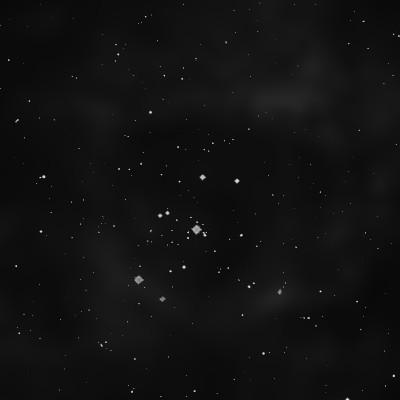
William Herschel discovered NGC 2244 = H VII-2 on 24 Jan 1784 (sweep 114) and described "the 12th Monocerotis is a beautiful scattered cluster of stars. They are chiefly of two sorts; the first very brilliant, and the 2nd sort arranged in beautiful winding lines; of these there are about 30 or more. There are besides many very small stars." Wolfgang Steinicke reports that Herschel first observed the cluster earlier on 13 Jan 1783 (before starting his sweeps) using his 6.2-inch reflector.
John Flamsteed recorded the 6th magnitude star 12 Monocerotis on his Atlas Coelestis (17 Feb 1690). But Stephen O'Meara notes that Flamsteed didn't note any of the fainter cluster stars (or general fuzziness), so doesn't deserve credit for the discovery.
200/250mm - 8" bright, large cluster in the center of the Rosette Nebula. The six brightest stars form a rectangular outline with the brightest star 12 Monocerotis (V = 5.9) at the SE corner. At the north and NW corners of the rectangle are two bright wide pairs with mag 7/8 stars. Many faint stars are near the center surrounding the wide pairs. Faint naked-eye cluster in dark sky.
400/500mm - 17.5" (2/11/96): unusually bright, large cluster of ~15'x5' elongated NW-SE in a rectangular outline and situated in the heart of the Rosette Nebula! The brightest 8 mag 6/7 stars lie along the sides and vertices of the rectangle with the brightest member, yellowish 12 Mon (V = 5.9), residing at the SE vertex. There are ~40 stars within the cluster although the only concentration is fifteen mag 11/12 stars surrounding mag 6.8 SAO 114010 (W of center) and trailing to the east towards the wide bright pair of mag 8 stars east of center (one of these stars is the double STF 926 = 9.2/10.3 at 5").
Notes by Steve Gottlieb